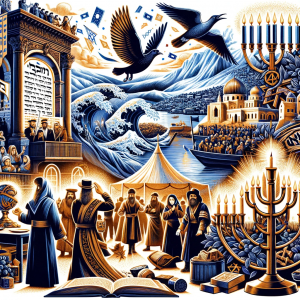Biblical Feasts and Holy Days (6of8)

Lesson 10: Lesser-Known Feasts and Their Meanings
Title: “Discovering the Hidden Gems: Lesser-Known Biblical Feasts”
Introduction
This lesson focuses on exploring lesser-known yet significant biblical feasts such as Purim and Hanukkah, diving deep into their historical roots, meanings, and the roles they play in both ancient and contemporary faith practices.
Discussion Points and Possible Answers
Lesser-Known Feasts:
- Purim:
- Celebration: Commemorates the saving of the Jewish people from Haman, as recounted in the Book of Esther.
- Customs: Reading the Megillah (Book of Esther), giving gifts to the needy, and sharing food with friends.
- Symbolism: Celebrates survival against odds, highlighting joy and gratitude.
- Hanukkah:
- History: Celebrates the rededication of the Second Temple in Jerusalem following the Maccabean Revolt against the Seleucid Empire.
- Traditions: Lighting the menorah, playing dreidel, and eating oil-based foods like latkes and sufganiyot.
- Significance: Symbolizes the miracle of the Temple’s menorah burning for eight days on a small amount of oil.
Historical and Biblical Significance
- Purim:
- Divine Providence: Demonstrates God’s protection of His people, often in hidden ways.
- Courage and Faith: Highlights Esther’s bravery and Mordecai’s wisdom.
- Hanukkah:
- Faith and Resistance: Emblematic of the Jewish fight for religious freedom and identity.
- Divine Intervention: The miracle of the oil is seen as a symbol of hope and divine presence.
Enhancing Understanding of God’s Plan
- Themes of Deliverance and Faithfulness: Both feasts serve as reminders of God’s enduring commitment to His people through times of trial.
- Preservation and Resilience: They symbolize the enduring spirit and faith of the Jewish people throughout history.
Summary
These feasts, while lesser-known, are integral to understanding the broader narrative of God’s interaction with His people. They highlight themes of providence, faithfulness, and the celebration of survival and freedom.
Biblical Story
- Purim: Details the story of Esther, who becomes queen and saves her people (Book of Esther).
- Hanukkah: Although not in the traditional canon, the story is found in the Books of 1 and 2 Maccabees, detailing the revolt and rededication of the Temple.
Related References
- The Book of Esther: Essential for understanding Purim’s story and themes.
- 1 and 2 Maccabees: Provides the historical context for Hanukkah.
- “Hanukkah: The Festival of Lights” by Rabbi Joseph Telushkin: Offers a comprehensive look at Hanukkah’s history and customs.
- “The Feast of Purim: Its Significance and Message” by David Baron: Explores the historical and spiritual aspects of Purim.
Conclusion
Understanding Purim and Hanukkah is crucial for appreciating the rich tapestry of Jewish history and faith. These festivals, with their unique stories and customs, not only commemorate historical events but also offer timeless lessons on resilience, faith, and the ongoing relevance of ancient traditions in modern times.

